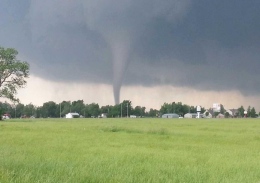Five Ohio State students were amazed yet horrified after witnessing the deadly tornado that pillaged Moore, Okla., Monday.
The students, who all study atmospheric science at OSU and were also with several OSU graduates of meteorology , saw the formation of the superstorm, including the initial touchdown of the tornado, from about a mile away in Newcastle, after traveling to Oklahoma Thursday to take part in an individually funded storm-chasing adventure alongside trained professionals.
The ruthless twister that claimed the lives of at least 24 people, including nine children, and left more than 200 injured was a gut-wrenching spectacle for the students, said Christie Lightfritz, a fifth-year in atmospheric sciences.
“Although this was something that we always wanted to see, we would have preferred it to be in a field where there’s nothing but cows and grass. Somewhere where there is no civilization,” Lightfritz said. “Unfortunately it didn’t line up that way.”
Despite feeling compelled to provide aid to those affected after the storm, the students agreed not to travel near heavily destructed sites so professional first-responders could effectively do their jobs, Lightfritz said.
“A lot of people in our group really wanted to go to Moore. We wanted to help out in any way we could. Some people had suggested going and giving blood, but we came to the consensus that it would be best to avoid destruction areas because we really needed the professional emergency responders to get in there and do their job and take care of the people that were affected by this tornado,” Lightfritz said
The students, though, agreed to bring awareness to those affected and to create a long-term plan of relief, John Banghoff, a third-year in atmospheric sciences, said.
“We are making every effort to make phone calls, make connections,” Banghoff said. “We want to turn this publicity, this experience we’ve had, into something better.”
The group has been making efforts to help while in Oklahoma. The students comforted a local man in a gas station who had been trying to return to his family in Moore before closed roads prevented him from getting there, Lightfritz said.
“We talked to him and tried to make him feel better. We told him that it would be okay and that his family was fine,” Lightfritz said. “We were trying to help out in any way that we could but there wasn’t really a whole lot that we could do.”
The tornado, which the National Weather Service said was an EF5 twister, the top of its scale with winds of at least 200 mph, formed almost instantly, showing how unpredictable weather can be, Lightfritz said.
Even though the storm developed quickly, there was fair warning for severe weather around southern Oklahoma, Jay Hobgood, director of OSU Atmospheric Sciences, said in an email.
“The National Weather Service’s Storm Prediction Center (SPC) issued a Moderate Risk for Severe Weather several days prior to the storms. That was a clear indication that the potential for severe weather existed,” Hobgood said.
The size of the tornado that leveled Moore is relatively rare, Hobgood said, but capable of large-scale destruction.
“Thunderstorms that produce tornadoes can develop very quickly and they can occur at any time of day or night. The number of severe thunderstorms and tornadoes was running below normal prior to this week, but we are still in the time of year when severe weather occurs,” Hobgood said. “Although large, strong tornadoes make up a small percentage of the total number of tornadoes, they are the most dangerous and destructive.”
The group of OSU students and graduates expect to travel back to Columbus Wednesday.
Liz Young contributed to this article.



